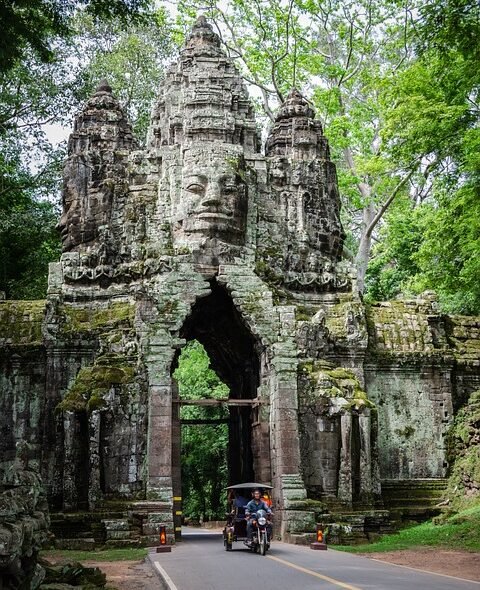| Topic | Information |
|—————————————-|—————————————————————————————————————————————————————————————|
| Best Time to Visit Siem Reap | – Dry season (November to April) is the best time to visit for sunny skies and lower humidity levels
– Shoulder months of November and April offer a nice balance between crowd levels and weather conditions |
| Must-Visit Temples in Siem Reap | – Angkor Wat: Largest religious monument in the world
– Bayon: Famous for enigmatic smiling faces
– Ta Prohm: Blend of nature and architecture
– Banteay Srei: Gem of pink sandstone carvings
– Preah Khan: Sprawling complex with labyrinthine corridors |
| Duration for Fully Exploring Temples | – 3 to 5 days recommended for exploring main temple complex, off-the-beaten-path temples, sunrise/sunset views, and rest and relaxation |
Unraveling the Mysteries of Siem Reap: Exploring Cambodia’s Ancient City
What is the best time of year to visit Siem Reap?
When planning a trip to Siem Reap, it is important to consider the weather patterns of the region. The best time to visit Siem Reap is during the dry season, which typically runs from November to April. During this time, you can expect sunny skies and lower humidity levels, making it ideal for exploring the ancient temples and ruins without being drenched in sweat. The shoulder months of November and April are particularly pleasant, as they offer a nice balance between manageable crowds and favorable weather conditions.
Some of the most iconic temples, such as Angkor Wat, Bayon, and Ta Prohm, are best enjoyed early in the morning or later in the afternoon. The soft morning light creates a magical ambiance, while the golden hour towards sunset bathes the temples in a warm glow, perfect for photography enthusiasts. Additionally, visiting Siem Reap during the dry season means you can avoid the inconvenience of navigating muddy, flooded paths around the temples, ensuring a more comfortable and enjoyable experience.
It is worth noting that the wet season in Siem Reap, which lasts from May to October, can bring heavy rainfall and high humidity levels. While the temples are still open for visitors during this time, exploring them in the sweltering heat and frequent downpours may not be as pleasant. However, the lush greenery and fewer tourists during the wet season can offer a unique perspective of the ancient city, making it a viable option for travelers who prefer quieter surroundings and don’t mind occasional showers.
Overall, the best time to visit Siem Reap is subjective and depends on your preference for weather conditions, crowd levels, and personal interests. Whether you choose to explore the temples during the dry season for optimal weather or embrace the tranquility of the wet season, Siem Reap’s ancient wonders will undoubtedly leave a lasting impression on your travel experiences.
What are the must-visit temples in Siem Reap?
When visiting Siem Reap, exploring the ancient temples is undoubtedly the highlight of any traveler’s itinerary. With over a thousand temples scattered throughout the region, it can be overwhelming to decide which ones to prioritize during your trip. To help you make the most of your visit, here are some of the must-visit temples in Siem Reap that showcase the rich history and architectural grandeur of the Khmer Empire:
1. **Angkor Wat** – As the largest religious monument in the world, Angkor Wat is a UNESCO World Heritage Site and a symbol of Cambodia. This iconic temple complex is known for its intricate carvings, imposing towers, and stunning sunrise views, making it a must-visit for history enthusiasts and photographers alike.
2. **Bayon** – Located in the heart of Angkor Thom, Bayon is famous for its enigmatic smiling faces carved into the stone towers. The temple’s unique architecture and spiritual significance make it a captivating site to explore, with hidden passageways and bas-reliefs depicting ancient Khmer life.
3. **Ta Prohm** – Known for its captivating blend of nature and architecture, Ta Prohm is a favorite among visitors for its overgrown trees and crumbling ruins. Made famous by the “Tomb Raider” movie, this temple offers a glimpse into the power of nature reclaiming man-made structures over time.
4. **Banteay Srei** – Located further away from the main temple complex, Banteay Srei is a gem of pink sandstone carvings dedicated to the Hindu god Shiva. The intricate details and delicate designs of this temple set it apart from the larger, more grandiose structures in Siem Reap.
5. **Preah Khan** – Built as a temple and Buddhist university, Preah Khan is a sprawling complex with labyrinthine corridors, decorative carvings, and serene courtyards. Exploring the hidden corners of this temple offers a glimpse into the spiritual and educational practices of the Khmer Empire.
While these are just a few of the must-visit temples in Siem Reap, the region is home to a myriad of lesser-known ruins and archaeological sites waiting to be discovered. Whether you choose to explore the iconic landmarks or venture off the beaten path, Siem Reap’s ancient temples offer a fascinating journey through Cambodia’s rich past.
How many days should I spend in Siem Reap to fully explore the temples?
Exploring the temples of Siem Reap is a once-in-a-lifetime experience that requires careful planning to make the most of your visit. The number of days you should spend in Siem Reap largely depends on your level of interest in archaeology, history, and temple exploration. While some travelers may be content with a brief visit to the main temples, others may prefer a more in-depth and immersive experience that spans several days. Here are some factors to consider when determining how many days to allocate for exploring Siem Reap’s temples:
1. **Main Temple Complex** – To visit the iconic temples of Angkor Wat, Bayon, and Ta Prohm, a minimum of two to three days is recommended. This allows you to explore each temple at a leisurely pace, take in the intricate carvings and architecture, and witness the temples in different lighting conditions throughout the day. Additionally, spending more time at the main temple complex ensures you can visit lesser-known temples and sites within Angkor Archaeological Park.
2. **Off-the-Beaten-Path Temples** – For travelers interested in exploring lesser-known temples and archaeological sites, an additional one to two days is advisable. This allows you to venture beyond the main temple complex and discover hidden gems such as Banteay Srei, Preah Khan, Banteay Kdei, and Neak Pean. These temples offer a more intimate and off-the-beaten-path experience, away from the crowds that flock to the popular sites.
3. **Sunrise and Sunset Views** – To fully appreciate the beauty of Siem Reap’s temples, consider allocating extra time for sunrise and sunset visits. Watching the sunrise over Angkor Wat or the sunset at Bayon can be a magical experience that adds a new dimension to your temple exploration. Plan ahead and arrive early to secure a prime viewing spot for sunrise, and stay late to capture the temples in the golden light of sunset.
4. **Rest and Relaxation** – Exploring the temples of Siem Reap can be physically demanding, with long hours of walking, climbing stairs, and navigating uneven terrain. To avoid temple fatigue and allow time for rest and relaxation, consider adding a rest day or half-day to your itinerary. Use this time to unwind at your hotel, indulge in a spa treatment, or explore Siem Reap’s vibrant markets and local cuisine.
Overall, the ideal duration for exploring Siem Reap’s temples is a minimum of three to five days, depending on your interests and preferences. Whether you choose to focus on the main temple complex, venture off the beaten path, or savor the magical sunrise and sunset experiences, spending a few days immersing yourself in Cambodia’s ancient city will leave you with memories to last a lifetime.



